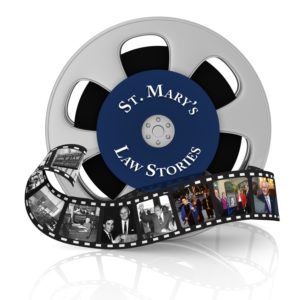St. Mary’s Law Stories
If you are a student or graduate of the law school, then your story interests us — whether you started law school years ago or just last August.
We would love for you to send a story from your time in law school, your time in practice or your whole story from start to now. Just get a video camera or a smartphone, and tell us your story.
Your help is very important to us, for this reason — Your story is St. Mary’s story. Without your story, we can’t tell ours nearly as well.

Getting Started
The easiest way to make a video history is to have one person run the camera and one person conduct the interview. There can be several storytellers sharing a story, such as classmates recounting their life in school together. Or, there can be one storyteller who just revives the memories of law school, practice and life.
Get a friend, spouse, child, parent or colleague to interview you. It helps if they know your life story in general. It is better if it is someone with whom you can be candid.
Write a list of questions to be answered during the recording and complete the Oral History Donation of Rights form.
Setting the Stage: Set, Sound, Light and Camera

The best place to record someone is where they are comfortable. Find a place that makes sense. It might be a home or office, or it could be at the law school itself. Think about the background. Check the camera to see if odd furniture or architecture is distracting from the storyteller.

Find a quiet place where you will not encounter interruptions. If possible, use a microphone on a cord or a cordless mic. You can use the mic in a video camera or phone, but be careful handling the camera or phone during the recording.

The best light comes from behind and above the camera. The worst light comes from behind the subject toward the camera.

If you use a video camera, make sure you have a cord, if needed, or enough batteries. Know how it stores its recording and check the memory. A tripod will keep the camera steady.
Getting the Whole Story: Who, Where, What, When and Why?
A Word About Research
Even if you are the storyteller, it might be worth taking a few minutes to think about what you’ve done, where you’ve been, who mattered to you and what mattered to you. If you see something you’d like to display in the video, feel free to do so. If you are the interviewer, consider doing more research before the recording. Ask family members and friends for questions to ask.
The Follow-Up Question
Follow-ups alert the storyteller to provide a specific detail in a story just told. For instance, someone who knows the story might not need a name, date or place, but a later viewer would need them to understand the story. A follow-up can also be used to signal to the storyteller that the interviewer would like to hear more about a topic.
Here is a list of sample questions.
Wrapping Up
If your recorder uses a tape or disc, label the tape or disc with the interviewee’s name and recording date. Please include the completed Oral History Donation of Rights form with your submission.
Law Archive
Sarita Kenedy East Law Library
St. Mary’s University School of Law
One Camino Santa Maria
San Antonio, TX 78228
If your recorder makes a computer file, please send the file to the law school at lawarchive@stmarytx.edu
Please let us know if you have any photos, books (especially yearbooks or notebooks), buttons, pins or other mementos from law school or practice that can be either donated or sent to St. Mary’s, copied and returned. We will make arrangements to have them sent to us at no cost to you. Please contact the law archive manager at lawarchive@stmarytx.edu.
We will be happy to give you a record of any donations for your records and tax receipts.
Thank you again for your care, your time and your story.